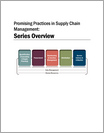-
Proven and Promising Solutions to Strengthening Maternal Health Supply Chains
August 28, 2014 By Katrina Braxton In 2012, as part of the Every Women Every Child movement, 13 vital health commodities were identified by a UN panel that could save the lives of more than 6 million women and children over the course of five years. There are often significant cultural and behavioral barriers to these commodities reaching people in low- and middle-income countries, but physical logistics is also a major problem.
In 2012, as part of the Every Women Every Child movement, 13 vital health commodities were identified by a UN panel that could save the lives of more than 6 million women and children over the course of five years. There are often significant cultural and behavioral barriers to these commodities reaching people in low- and middle-income countries, but physical logistics is also a major problem.In Promising Practices in Supply Chain Management, members of the UN’s Supply and Awareness Technical Reference Team present a series of eight briefs outlining case studies of “proven” and “promising” practices to getting these and other life-saving medicines into the hands of more people.
The technical reference team identifies seven key areas of concern: quantification; procurement; warehousing; distribution; service delivery and utilization; data management; and human resources.
13 vital health commodities could save the lives of more than 6 million women and children
Poor transportation infrastructure is pinpointed as a critical barrier that encompasses several areas. This encompasses the transfer of commodities from central warehouses to service delivery points, like rural health facilities, where reliability, availability, and quality of commodities can easily be compromised by poor roads or a lack of staff to help with delivery.
The authors suggest investing in more vehicles, more drivers, and tracking systems for deliveries that monitor consumption and stock levels. A 2002 case study highlights the success of such measures in improving the distribution of vaccines to over 400 health centers in northern Mozambique.
In many of the biggest problem countries, the government manages health supply lines, and the authors also suggest outsourcing distribution to more private providers. “It does not eliminate the government’s role in distribution, but rather shifts it from managing transportation to monitoring, evaluation, and actively managing a relationship with a third-party provider,” they write.
In the last brief, the technical reference team provide examples of proven practices as well as selection criteria and reference articles. These practices provide ministries of health and their affiliates practical guidance on ways supply chain management systems have been scaled up in the past.
However, the authors caution that the suggested solutions may not be applicable in all contexts as health systems vary by country. In addition, they find a limited number of proven practices overall; it’s important, therefore, to continue sharing experiences so promising practices can be built on and perhaps implemented elsewhere.
Sources: UN Commission on Life-Saving Commodities for Women’s and Children’s Health.
Topics: Africa, Bangladesh, Chile, community-based, development, Dot-Mom, global health, India, maternal health, Mozambique, Pakistan, poverty, Reading Radar, UN, youth
 A Publication of the Stimson Center.
A Publication of the Stimson Center.




